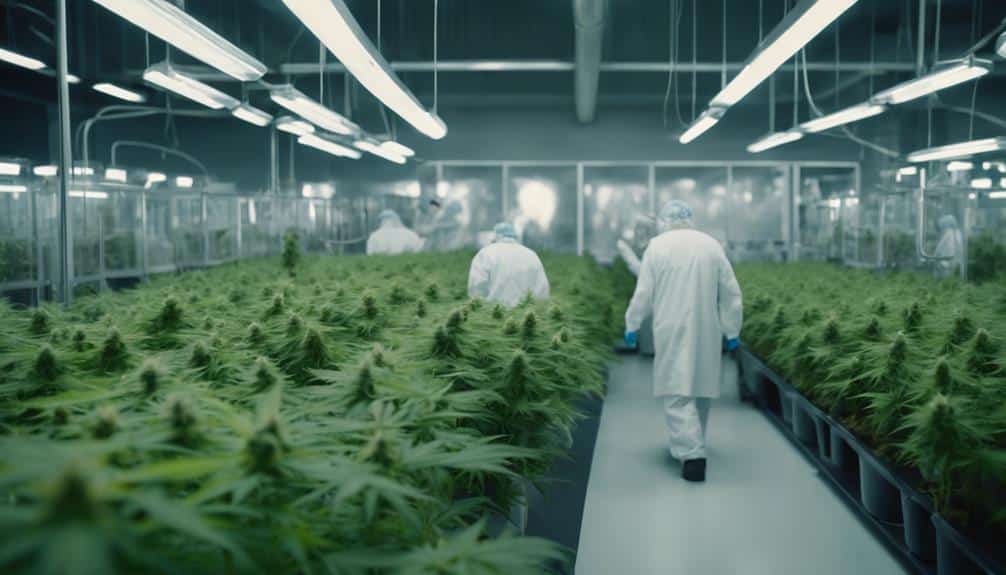Imagine a world where every ailment, from chronic pain to severe epilepsy, could be effectively treated with cannabis. You’re at the forefront of a rapidly evolving medical field, where the once demonized plant is now hailed as a potential game-changer.
Table of Contents
However, this world is fraught with uncertainties, regulatory hurdles, and uncharted territories. As you navigate this intriguing landscape, wouldn’t you want to understand the future trends shaping the medical cannabis industry?
Hold onto that thought; we’re about to embark on an enlightening exploration.
Understanding Medical Cannabis: The Basics

You might find it surprising that medical cannabis—a plant species with over 100 active compounds—has become an integral part of healthcare due to its diverse therapeutic potentials. When administered under the right dosage guidelines, it can provide relief from pain, seizures, anxiety and various other ailments.
Navigating the complexities of dosage isn’t straightforward. It’s essential to understand that the therapeutic efficacy of cannabis isn’t a one-size-fits-all concept. The dosage depends on several factors including patient’s body weight, condition being treated and individual tolerance levels. Therefore, a careful systematic approach is needed when administering cannabis to ensure optimum health benefits while minimizing potential side effects.
Patient experiences also play a crucial role in shaping the medical cannabis narrative. Real-life stories highlight the positive impact cannabis can have on health and well-being when used responsibly. However these stories also underscore the need for further research and consistent, reliable guidelines on usage and dosage.
In essence, medical cannabis holds promise, but it’s a promise that needs careful handling. The journey towards understanding its full potential is still underway, and we’re all part of it.
Recent Advances in Cannabis Research
Building on our understanding of medical cannabis, let’s now explore the recent breakthroughs in cannabis research that are reshaping our perception of its therapeutic potential. Two key areas that have witnessed significant advancements are Cannabinoid Synthesis and Strain Genetics.
Cannabinoid Synthesis—the process of creating cannabinoids in a lab setting—has seen substantial progress. This leap forward allows for the production of rare cannabinoids that aren’t easily accessible in nature, broadening the potential for new treatments. By creating these unique cannabinoids scientists can delve deeper into the plant’s therapeutic properties enhancing our understanding of its medicinal use.
Turning to Strain Genetics, advancements here are unlocking insights into the plant’s genetic makeup. Different cannabis strains have diverse medicinal properties. By understanding the genetics of these strains researchers can refine and develop targeted treatments. This knowledge also enables breeders to cultivate strains with specific therapeutic profiles—a significant step towards personalized cannabis medicine.
As we continue to unravel the mysteries of cannabis these advancements are pushing the boundaries of its medical applications. Remember we’re just scratching the surface; the future holds even more exciting revelations.
The Impact of Legalization on Medical Cannabis

Undoubtedly, the recent wave of cannabis legalization in numerous jurisdictions is having a profound effect on its medical applications and research opportunities. The implications of legalization are creating a paradigm shift impacting both the market dynamics and the scientific community.
We’re witnessing a surge in research funding revealing new therapeutic applications of cannabis. This wouldn’t be possible without legalization, which has opened the door to more comprehensive clinical trials and improved patient access. It’s also leading to increased standardization and quality control in cannabis-based products ensuring safer, more effective treatments.
As for market dynamics they’re evolving rapidly. The broadening acceptance of cannabis is driving demand leading to an expanding market and the formation of numerous cannabis-related enterprises. This growth isn’t without its challenges though. Regulatory hurdles, varying state laws, and patient education are just a few complexities you’re grappling with in this emerging field.
In short, legalization is playing a pivotal role in shaping the future of medical cannabis. While it presents its own set of challenges it’s also paving the way for significant advancements in patient care and scientific understanding.
The Future Applications of Medical Cannabis
Looking ahead, potential applications of medical cannabis are set to revolutionize healthcare in various ways. The exploration into Cannabis Genomics and Cannabinoid Biosynthesis has opened doors to novel treatments and interventions.
- Cannabis Genomics: Understanding the genetic makeup of cannabis plants can lead to strains tailored for specific medical conditions. You could be prescribing cannabis-based treatments that are genetically optimized for a patient’s individual needs.
- Cannabinoid Biosynthesis: This process enables creation of cannabinoids in a laboratory setting. In future you won’t be limited to natural variations found in cannabis plants; you’ll have the ability to produce targeted cannabinoids that could offer increased efficacy and reduced side effects.
- Personalized medication: With advancements in genomics and biosynthesis, personalized medical cannabis treatments could become the norm. You’d be able to provide bespoke treatment plans enhancing patient outcomes and improving quality of life.
Challenges and Controversies Surrounding Medical Cannabis

Despite the promising future of medical cannabis it’s not without its array of challenges and controversies that need meticulous addressing. Among the most prominent issues is the lingering stigma around cannabis. Despite its proven therapeutic benefits society often still views cannabis use with suspicion or outright prejudice. This perception might hinder patients from seeking treatment they need or even discussing it openly with their healthcare providers.
Patient accessibility to medical cannabis is another significant hurdle. Regulations vary wildly not just between countries but also within regions of same country. This inconsistent landscape makes it difficult for patients to access treatment and for healthcare providers to prescribe it. Moreover cost can also be a deterrent as medical cannabis isn’t typically covered by insurance making it an out-of-pocket expense many can’t afford.
Navigating these challenges is critical for future of medical cannabis. Efforts should be directed towards educating public to dissipate stigma around cannabis, advocating for policies that improve patient accessibility. Only by addressing these issues can we truly unlock potential of cannabis in medical field.
Conclusion
As you navigate the shifting landscape of medical cannabis, stay mindful of the challenges and controversies. Despite the hurdles a promising statistic paints a vivid picture: according to National Academies of Sciences, Engineering, and Medicine over 10,000 scientific abstracts indicate substantial evidence for cannabis treating chronic pain. The future of medical cannabis holds immense potential but it’s up to us to responsibly harness and explore its full medicinal value.
I’d like to personally invite you to learn more about this fascinating field. Visit us at Cannabis Docs of Delaware where we’re always ready to answer your questions and provide you with latest information. If you prefer a more personal approach just give us a call. We’d be more than happy to chat and help you navigate this promising area of medicine. Remember the future of medical cannabis is unfolding and we’d love for you to be part of our journey.

